Related Research Articles

Baba Ramdev is a Hindu folk deity of gujarat and Rajasthan, India. He was a fourteenth-century ruler, said to have miraculous powers, who devoted his life to the upliftment of the downtrodden and poor people of society. He is worshiped by many social groups of India as Ishta-deva.

Bochasanwasi Akshar Purushottam Swaminarayan Sanstha, is a Hindu denomination within the Swaminarayan Sampradaya. It was formed in 1905 by Yagnapurushdas following his conviction that Swaminarayan remained present on earth through a lineage of gurus starting with Gunatitanand Swami.
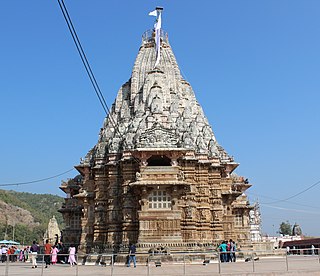
Shamlaji, also spelled Shamalaji, is a major Hindu pilgrimage centre in Aravalli district of Gujarat state of India. The Shamlaji temple is dedicated to Vishnu. Several other Hindu temples are located nearby.

Salasar Balaji is a religious place for the devotees of Lord Hanuman. It is located in Churu district of Rajasthan. Salasar Dham is visited by innumerable Indian devotees throughout the year. Every year big fairs are organized on Chaitra Purnima and Ashwin Purnima. During this time, millions of devotees gather here to have a vision of this revered deity. There are many dharamshalas to stay here and many restaurants to eat and drink. The Sri Hanuman Temple is located right in the middle of Salasar town. #Jai Shri Balaji
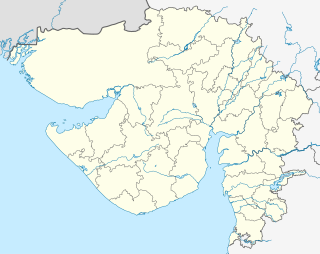
Ambaji (Ambājī) is a census town in Banaskantha district in the state of Gujarat, India. It is known for its historical connections with sites of cultural heritage.
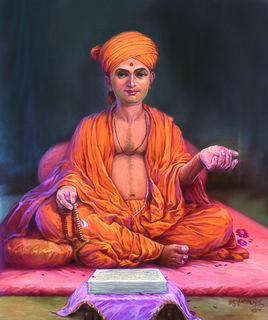
Gunatitanand Swami, born Mulji Jani, was a prominent paramhansa of the Swaminarayan Sampradaya who was ordained by Swaminarayan and is accepted as the first spiritual successor of Swaminarayan by the Bochasanwasi Akshar Purushottam Swaminarayan Sanstha (BAPS). Born into a religious family in the small farming community of Bhadra in Gujarat, India, he first received religious education under his father's guru, Ramanand Swami before encountering Swaminarayan and becoming a swami under him at the age of 25. He was revered for his spiritual discourses and divine service

Khedbrahma is a town and a taluka headquarter in Khedbrahma Taluka of Sabarkantha district, Gujarat, India. It is situated on the banks of Harnav river. The town is connected with mythological history and has been pilgrim site for centuries. The 11th century Brahma, Ambika and Pankhnath Mahadev temples are the oldest monuments of the town. The town has two old stepwells, the Brahma stepwell and the Aditi stepwell. It was under Parmaras, Chaulukyas and Pariharas before it came under Idar State in 13th century.
The culture of Gujarat is both ancient, new, and modern.

Kartika Purnima is a Hindu, Sikh and Jain cultural festival, celebrated on the Purnima day or the fifteenth lunar day of Kartik (November–December). It is also known as Tripuri Purnima and Tripurari Purnima. It is sometimes called Deva-Diwali or Deva-Deepawali, the festival of lights of the gods. Karthika Deepam is a related festival celebrated in South India and Sri Lanka on a different date.
Baneshwar fair is an annual tribal fair held in Dungarpur district in Rajasthan state of India. The fair is held in the month of January or February at Baneshwar, near the confluence of the Som and Mahi rivers. This fair is a major fair in tribal culture and has been described as "the Kumbh mela for the tribals".

Becharaji or Bahucharaji is a Hindu temple town and taluka capital in Mehsana district of Gujarat state, India. The temple of Hindu goddess Bahuchara Mata in the town is major pilgrimage centre.

Gujarat is the 6th largest state in India, located in the western part of India with a coastline of 1,600 km. It is 9th most popular tourist regions in the country and was visited by 54.4 million domestic and international tourists in 2018.

Kālikā Mata Temple is a Hindu goddess temple complex and pilgrim centre at the summit of Pavagadh Hill in Panchmahal District, India, with in the Champaner-Pavagadh Archaeological Park. It dates from the 10th or 11th centuries. The temple has three images of goddesses: the central image is of Kalika Mata, flanked by Kali on the right and Bahucharamata on the left. On Chitra sud 8, a fair is held at the temple which is attended by thousands of devotees. The temple is the site of one of the Great holy Shakti Peethas. One can reach easily to temple by ropeway.

The Akshar Deri is a major site of pilgrimage in the Swaminarayan Sampradaya and is located in the rang mandap of the BAPS Swaminarayan temple in Gondal, India. The structure marks the cremation site and serves as a memorial to Gunatitanand Swami. An event was held to commemorate 150 years of the structure in Gondal, the structure as well as the site was renovated to bring it to modern standards.
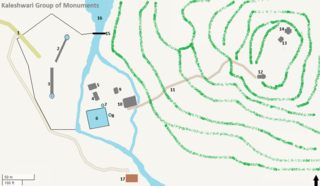
The Kaleshwari Group of Monuments, also known as Kaleshwari-Ni Nal, is located near Lavana village, Khanpur Taluka of Mahisagar district, Gujarat, India. It is near the district headquarters Lunavada and near a stream in Hidimba Van, the forest of Hidimba. The group includes intricately-carved temple ruins, two stepwells, a reservoir, structures with panels of erotic sculptures and idols scattered all over the site. The ruins are located at the foothills and on the hillock. They were built between the 10th and 16th century; some monuments were reconstructed after the 18th century. These are State Protected Monuments.

Vautha fair is one of the important fairs held in Gujarat. Vautha is located on the border of Dholka taluka of Ahmedabad district and Matar taluka of Kheda district. Vautha fair is the largest fair in Ahmedabad district.
Dangs Darbar is a fair organized during the Holi festival in Ahwa, the headquarters of Dangs district of Gujarat, India. Five old Dang Darbars are given shirpav (pension) by the government in Dangs Darbar. At the Dang Darbar, traditionally held in the Dang area, tribal people performed their dances and music and it was celebrated as a festival.
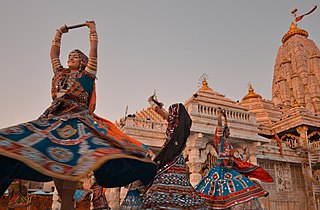
Ambaji Fair is held at Ambaji in Danta taluka of Banaskantha district. Ambaji, 50 km away from Palanpur, creates the same atmosphere as every Poonam fair. But, in all, big fairs are held here on Purnima of Kaartik, Chaitra, Bhadarvo and Asho(Ashwina) months. In which 'Bhadarvi Purnima's fair' is a very important and big fair.
Chul fair is held on Dhuleti at Gangardi of Garbada taluka and Raniyar village of Zhalod taluka.Tribals of Panchmahal, Bharuch and Vadodara districts also enjoy Chul fair on Dhuleti day.

Bhavnath fair is held at the Foothills of Girnar mountain in Junagadh, Gujarat on the banks of the river Suvarnarekha. Bhavnath Fair is one of the important fairs of Gujarat.
References
- 1 2 3 4 5 Sedani, Hasutaben Shashikant (2015). ગુજરાતની લોકસંસ્કૃતિ. Ahmedabad: University Granth Nirman Board - Gujarat. p. 85. ISBN 97-89-381265-97-0.
- 1 2 3 4 Vyas, Rajni (2012). ગુજરાતની અસ્મિતા (5th ed.). Ahmedabad: Akshar Publication. p. 325.
- 1 2 Kalariya, Ashok (2019–20). ગુજરાતના લોકોત્સવો અને મેળા. Gandhinagar: Directorate of Information/ GujaratState. pp. 28–29.
- ↑ Vyas, Rajni (2012). ગુજરાતની અસ્મિતા (5th ed.). Ahmedabad: Akshar Publication. pp. 38–40.